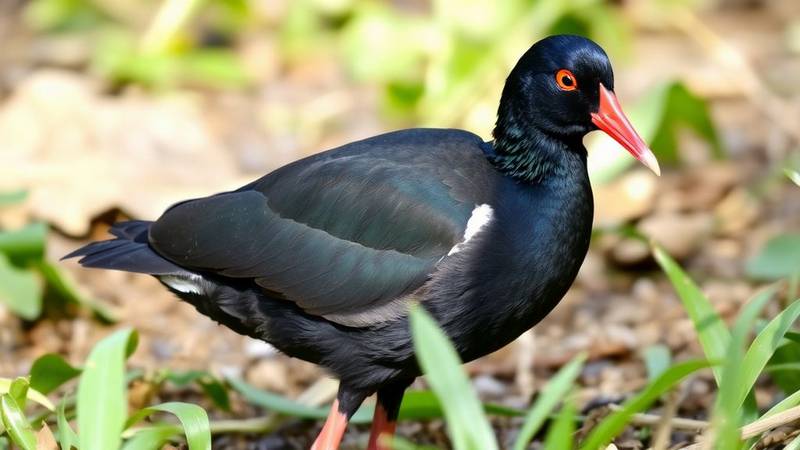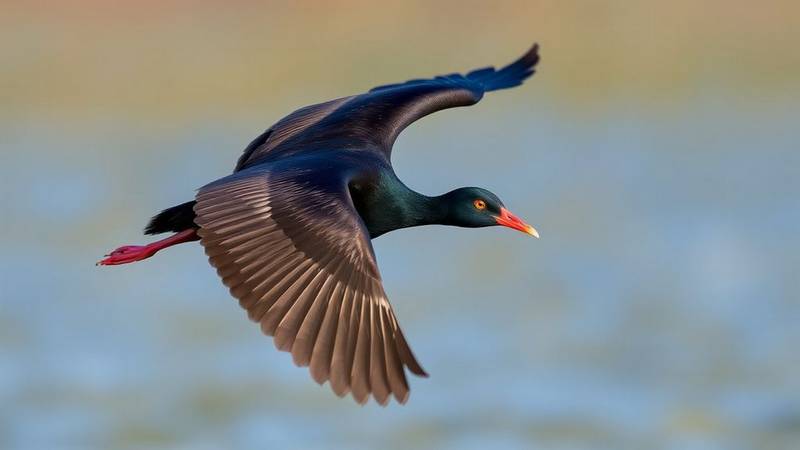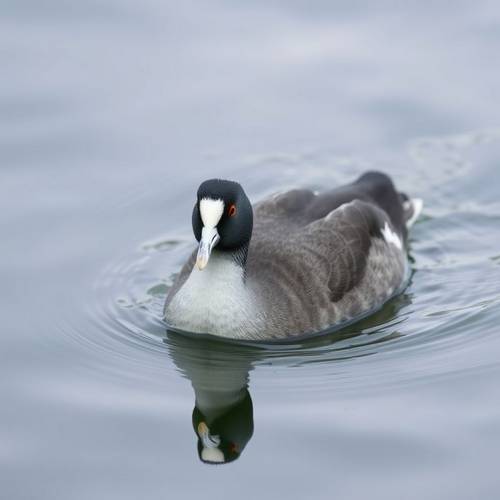Behavior and Nesting
The Common Moorhen is generally a solitary and highly territorial bird, especially during the breeding season when it fiercely defends its space against intruders and other moorhens. Despite its shy nature, it may venture into open areas near the banks if it feels safe.
Nesting
The Moorhen's nest is a bulky, cup-shaped structure, built with reeds, grasses, and other plant stems. It is usually well-hidden in dense, emergent vegetation at the water's edge, sometimes floating or on bushes and small trees near the water. If water levels rise, the parents can raise the nest to protect the eggs.
- The nesting period extends from mid-March/April to early August.
- The female typically lays 5 to 11 eggs (more frequently 5 to 9), which are smooth, glossy, cream-colored or off-white, and spotted with dark markings.
- There can be 2 or 3 broods per year.
- Incubation lasts approximately 17 to 22 days, and is shared by both parents.
- Chicks are precocial (leave the nest shortly after hatching), able to swim and dive within 3 days.
- Young from earlier broods may help their parents feed the chicks of subsequent clutches, demonstrating strong sibling bonds.
Common Moorhen's Diet: A Diverse Omnivore
The Common Moorhen is an omnivorous and opportunistic bird. Its diet is highly varied and adapts to the resources available in its aquatic and riparian habitat.
What the Common Moorhen eats:
It feeds primarily by plucking aquatic plants or by foraging on the banks and in shallow water.
- Vegetation: Aquatic plants (duckweed, rushes, buttercups, mosses, sedges, pondweeds), grasses, leaves from trees and bushes, seeds, and berries.
- Animals: A wide range of invertebrates such as insects (grasshoppers, beetles, dragonflies, flies, mayflies, bugs), spiders, mollusks (slugs, snails), and earthworms. It may also consume small fish, tadpoles, crustaceans, and occasionally even the eggs of other birds.
Although it rarely dives for food, it can do so and remain submerged for over 30 seconds to find food. It does not properly digest cereals, and it is advised not to feed it bread.
Call and Vocalizations: A Characteristic Sound Repertoire
The Common Moorhen has a rich and varied vocal repertoire, often harsh, muffled, or even shrill depending on the context. Its vocalizations are very distinctive and make it easily identifiable, even if it often remains hidden.
Its main calls include:
- A brief, dry, and piercing alarm call, often transcribed as “krrou”, “trrou” or “kittick”, emitted in response to a threat.
- Rapid and repeated clucking sounds, often audible in flight, especially at night in spring, for intraspecies communication.
- Territorial calls, series of short, repeated, clacking sounds, often transcribed as “kick kick kick” or “kté kté kté”, to mark its presence and deter intruders.
Migration and Habitat of the Common Moorhen
The Common Moorhen is a widely distributed species found across many parts of the Old World, across Africa, Europe, and Asia, and also in the Americas, with the exception of polar regions and many tropical rainforests.
Although generally considered sedentary in regions where waters do not freeze, populations in areas with harsh winters may undertake nocturnal migrations over short to medium distances. These movements typically occur between September and November for the journey to more temperate wetlands in Central Europe and the Mediterranean basin, and from March to May for the return. Populations breeding in southern and western Europe are largely sedentary or show short-distance dispersal during winter.
Habitat
The Common Moorhen occupies a wide variety of freshwater or brackish aquatic environments, avoiding only highly saline waters (sea) and excessively high altitudes. It prefers wetlands with abundant and dense vegetation, offering cover and food.
- Ponds, lakes, slow rivers, and canals.
- Marshes (alluvial, peat, brackish) and reedbeds.
- It also adapts to urban environments, frequenting parks and gardens with water bodies.
Distribution Map
Conservation Status and Symbolism
Conservation Status
The Common Moorhen is currently classified as "Least Concern" (LC) on the IUCN Red List. Its global population is considered stable, and it is widespread. In Europe, its conservation status is generally favorable.
However, like many wetland species, it remains susceptible to habitat degradation, particularly the drainage of alluvial plains and the lowering of water tables. Some local populations, such as in Hawaii and Guam, are endangered due to habitat destruction and predation. Therefore, wetland conservation efforts are essential to maintain its populations.
Cultural Symbolism
Less emblematic than the White Stork, the Common Moorhen nevertheless symbolizes adaptability and resilience. It represents the discreet and often hidden life that thrives in wetland ecosystems. Its familiar yet elusive presence embodies the richness and biodiversity of these essential environments. Its scientific name, Gallinula chloropus, means "little hen with green feet" (or yellowish-green feet), a nod to its appearance and habitat.
Frequently Asked Questions About the Common Moorhen
Where does the Common Moorhen build its nest?
The Common Moorhen builds a bulky, cup-shaped nest from reeds and aquatic vegetation. It is typically well-hidden in dense vegetation at the water's edge, sometimes floating or on bushes and small trees near the water.
What does a Common Moorhen eat?
The Common Moorhen is an omnivore with a varied diet. It feeds on aquatic plants (leaves, seeds, berries), insects, mollusks (slugs, snails), earthworms, and occasionally small fish, tadpoles, and even bird eggs.
Does the Common Moorhen migrate?
The Common Moorhen is generally sedentary in temperate regions, but populations in the northern parts of its range migrate south during harsh winters. Migrations occur at night, primarily between September and November for the outbound journey, and March to May for the return.
What does the Common Moorhen's call sound like?
The Common Moorhen is known for its varied vocalizations, including a short, dry, piercing alarm call, often transcribed as “krrou” or “kittick”. It also emits rapid, repeated clucking sounds and territorial “kick kick kick” series.
What is the conservation status of the Common Moorhen?
According to the IUCN, the Common Moorhen is classified as 'Least Concern' (LC) with a stable population trend. It is a widespread and common species, although it can be locally affected by habitat degradation.


